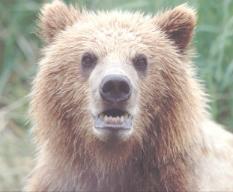Bears have several types of vocalizations. Some species vocalize more than others. Knowing what these sounds mean can help us understand bear behavior and help with their care.
 Photo of brown bear yearlings play-fighting and vocalizing in Alaska. photo credit: Chris Morgan.
Photo of brown bear yearlings play-fighting and vocalizing in Alaska. photo credit: Chris Morgan.Giant pandas have some unique vocalizations. They bleat which is a friendly greeting, honk when anxious or distressed and during the breeding season a receptive female will chirp when meeting a male. Sloth bears make a huffing sound when sucking up food, which sounds like a vacuum.
Most bear species make vocalizations that sound like a huff, chomp, woof, growl, and/or bark which mean the bear is agitated, angry or annoyed. A bawl, bellow, squeal or whimper indicates pain. A mumble, hum, or purr indicates contentment.
In many cases vocalizations are done along with some type of body posturing. These are visual clues as to how the bear is feeling. Depending on how the bear is standing, holding its head, the ear placement and how they move can tell a lot about what the bear is thinking and whether it is a dominant or subordinate animal. Bears would rather avoid a fight so using vocalizations and posturing can help eliminate serious conflicts and injuries and along with this, conserve energy they need to survive.
Vocalizations can be heard on the North American Bear Center’s website.
Wendy Gardner, GBOP team
